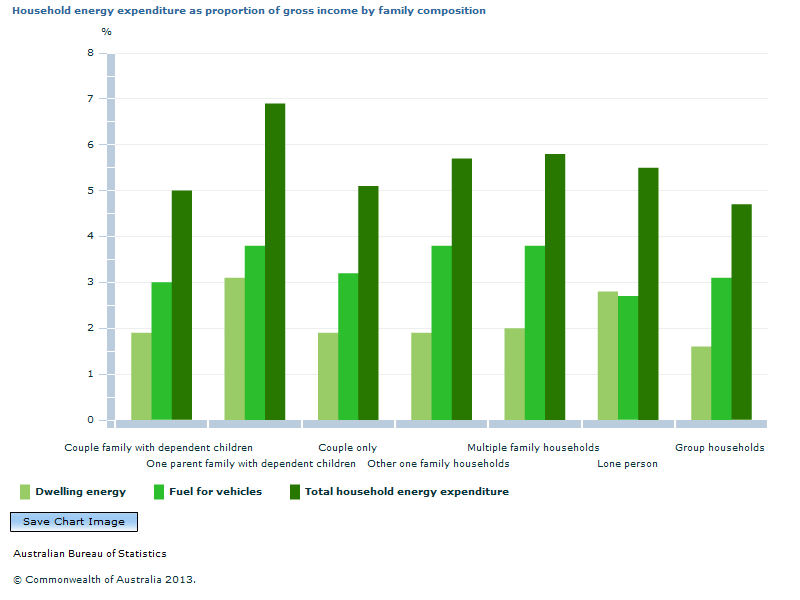Page tools:
 Print Page Print Page
 Print All Print All
| ||
|
Energy expenditure and consumption Dwelling characteristics Energy-related behaviours and perceptions
.gif) Among other household types, lone person households had the lowest total energy costs ($49 per week), while multiple family households had the highest average number of people (5.3 persons per household), and the highest average energy expenditure ($176 per week). It is also possible to look at energy costs as a proportion of gross household weekly income. Using this approach, one parent families with dependent children have the highest relative energy costs, representing 6.9% of their gross household income, significantly higher than that of all other household types. Couple families with dependent children, couples only and group households had the lowest relative energy costs (5.0%, 5.1% and 4.7% respectively).  Energy consumption patterns, in terms of units of energy consumed in their dwellings, generally followed expenditure patterns among groups based on their family composition type. (Endnote 2) Among family households for instance, couple families with dependent children and 'other' one family households consumed similar amounts of electricity on average (159.1 kilowatt hours (kWh) and 156.0 kWh respectively), while lone person households used the least amount (75.1 kWh per week). Bottled gas consumption however was similar across most family composition types. Dwelling characteristics Nine in every ten (90%) couple family households with dependent children lived in a separate house, significantly higher than other one family household types (where between 81 and 84% lived in separate houses). Lone person and group households were less likely to live in a separate house (61% and 58% respectively), instead occupying other dwelling types such as flats, units, apartments or townhouses at higher rates than family households. Solar electricity and hot water systems were more common among couple families (around 19% of those with dependent children or living by themselves) and 'other' one family households (16%) than one parent families with dependent children (7%). Lone person and group households also had lower rates of solar systems (9% and 10% respectively). Electric hot water systems were more common among one parent families with dependent children (52%) than 'other' one family household types. A similar rate of lone person households also used electric hot water systems (55%). Energy-related behaviours and perceptions Compared to lone persons, more couple families and 'other' one family households used energy efficient light bulbs in most of their lights, used cold water for all or most of their clothes washing, used low flow shower heads and switched off chargers for rechargeable appliances when not in use. One parent families were less likely to dry clothes on a washing line for all or most washes (82%) than 'other' one family households (between 86% and 90% performed these actions). (Endnote 3) More couples with dependent children (29%) than couples living by themselves (26%) perceived heating their home as the activity which contributed most to their household energy costs in the last 12 months. Almost a third of 'other' one family households (30%) perceived water heating as the main activity contributing to their energy costs, significantly higher than for couples with dependent children (24%).
Document Selection These documents will be presented in a new window.
|
|
4670.0 - Household Energy Consumption Survey, Australia: Summary of Results, 2012
ARCHIVED ISSUE Released at 11:30 AM (CANBERRA TIME) 24/09/2013 First Issue
This page last updated 29 August 2014
